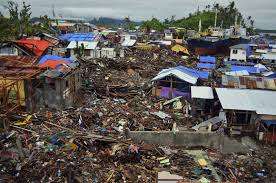Typhoon Haiyan (Yolanda) in 2013 was one of the strongest tropical cyclones ever recorded, causing widespread devastation in the Philippines, particularly in Tacloban, with over 6,000 deaths and significant damage.
ADVERTISEMENT

Table of Contents
Typhoon Haiyan (Yolanda)

Typhoon Haiyan (Yolanda) was one of the most powerful and destructive tropical cyclones in recorded history. Striking the Philippines on November 8, 2013, it reached Category 5 status with sustained winds of 195 mph (315 km/h) and gusts of up to 235 mph (380 km/h). The storm brought catastrophic damage to the central Philippines, particularly the Visayas region, with Tacloban City in Leyte experiencing near-total devastation due to wind damage and storm surges as high as 20 feet.
Human Impact: Haiyan resulted in over 6,000 confirmed deaths, left thousands injured, and displaced more than four million people. The massive storm surge swept away homes and infrastructure, contributing to the high death toll and displacing entire communities. In total, millions were affected by the typhoon’s destruction.
Economic Damage: The estimated economic impact exceeded $14 billion (USD), significantly affecting agriculture, homes, and essential services. Crops such as rice and coconut were decimated, severely impacting local economies and food security.
Relief and Response: The scale of the disaster triggered a global humanitarian response, with countries and organizations providing financial aid, supplies, and support teams. Initial relief efforts faced challenges due to damaged roads, communication breakdowns, and logistics issues.
Legacy and Reforms: Typhoon Haiyan underscored the importance of effective disaster preparedness and response. It led to significant policy changes in the Philippines, including the improvement of early warning systems, stricter building codes, and enhanced disaster management protocols. The storm is remembered not only for its devastating impact but also as a symbol of resilience and recovery.
Typhoon Haiyan (Yolanda): A Comprehensive Overview
I. Introduction
Typhoon Haiyan, or Yolanda as it is known locally, stands as one of the most catastrophic natural disasters in Philippine history. Striking the archipelago on November 8, 2013, Haiyan brought unprecedented devastation that not only reshaped communities but also transformed the country’s approach to disaster preparedness and management.
II. Formation and Path
Meteorological Background:
Typhoon Haiyan formed in the western Pacific Ocean as a tropical depression on November 2, 2013. Due to favorable conditions, such as warm ocean waters and low wind shear, it rapidly intensified into a super typhoon within days.
Route and Landfall:
Initial Landfall:
Haiyan made its first landfall in the town of Guiuan, Eastern Samar, with sustained winds of 195 mph (315 km/h), categorizing it as a Category 5 typhoon.
Path Across the Philippines:
It swept westward, striking provinces like Leyte, Samar, and northern Cebu, before moving toward the South China Sea.
Duration:
Haiyan maintained its intensity through most of its path over land, contributing to its widespread destruction.
III. Strength and Intensity
Unprecedented Force:
Haiyan’s maximum sustained winds and gusts were among the highest recorded globally, likened to a strong tornado but sustained over vast areas.
Storm Surges:
Impact on Tacloban:
One of the most devastating effects was the storm surge, with waves as high as 20 feet flooding coastal communities in Tacloban City. These surges were described as “tsunami-like,” sweeping away buildings and vehicles.
Rainfall and Flooding:
While wind speeds garnered the most attention, torrential rains led to extensive flooding, worsening the humanitarian crisis in affected areas.
IV. Impact on the Philippines
Geographic Extent:
Most Affected Regions:
The Visayas region, particularly Leyte and Samar provinces, bore the most severe impact. Tacloban City, known for its bustling urban life, was nearly obliterated.
Humanitarian Toll:
Death and Injury:
Haiyan claimed the lives of over 6,300 people, with some reports indicating higher numbers due to unconfirmed cases. Injuries were widespread, with many suffering from trauma and long-term disabilities.
Displacement:
Over four million individuals were displaced, many of whom sought refuge in evacuation centers that quickly became overwhelmed by the sheer volume of evacuees.
Economic Impact:
Total Damages:
The typhoon caused damages exceeding $14 billion (USD), impacting infrastructure, homes, and essential public facilities.
Agricultural Losses:
The storm wiped out rice and coconut crops, affecting thousands of farmers and contributing to food shortages and economic setbacks. Livestock losses further deepened the economic burden on rural communities.
Infrastructure Destruction:
Roads, bridges, ports, and power lines were severely damaged or completely destroyed, hindering rescue and relief efforts. Hospitals and schools were also devastated, leading to long-term recovery challenges.
V. Immediate Response and Relief Efforts
Governmental Response:
Initial Challenges:
The Philippine government faced significant obstacles in coordinating emergency response due to the scale of destruction, communication breakdowns, and logistical constraints.
Military and Local Agencies:
Deployed to clear debris, provide medical aid, and distribute essential supplies, but struggled with the magnitude of the crisis.
International Assistance:
Global Aid and Solidarity:
Countries such as the United States, Japan, the United Kingdom, and Australia provided critical support, including financial aid, medical teams, and military assets for logistics and supply distribution.
NGOs and UN Involvement:
Organizations like the Red Cross, UNICEF, and the World Food Programme played pivotal roles in delivering food, water, and medical supplies to affected communities.
Challenges in Relief Operations:
Access Issues:
Roads blocked by debris and damaged airports delayed the arrival of aid, while initial coordination failures added to the logistical hurdles.
Health and Sanitation:
Overcrowded evacuation centers faced risks of disease outbreaks due to poor sanitary conditions.
VI. Long-term Impact and Recovery
Rehabilitation Efforts:
Government and NGO Collaboration:
Rebuilding efforts included constructing new homes designed to withstand future storms and restoring essential services like electricity and water supply.
Community Initiatives:
Local communities played active roles in rebuilding, often relying on international partnerships for funding and resources.
Economic Recovery:
Slow Agricultural Rebuild:
The extensive destruction of farmland resulted in a prolonged recovery period for local economies dependent on agriculture.
Job Creation Programs:
Government and non-profit organizations initiated job programs to help displaced individuals gain income during the recovery phase.
Policy Reforms:
Disaster Response Improvements:
The impact of Haiyan led to significant policy changes, including enhancements to the early warning system, better evacuation protocols, and the establishment of a centralized disaster management agency.
Stricter Building Codes:
New regulations mandated more resilient construction standards for homes and public structures to withstand future typhoons.
VII. Legacy
Resilience and Memory
Typhoon Haiyan’s impact was a profound testament to the resilience of the Filipino people. Despite the scale of destruction, affected communities displayed remarkable strength and unity in rebuilding their lives. Tacloban City and surrounding areas became symbols of hope and recovery, as residents worked together to reconstruct homes, restore livelihoods, and rebuild public infrastructure. Annual memorials, community events, and stories of survival ensure that the memories of those lost are honored and that the experiences of the survivors remain at the forefront of national consciousness. These acts of remembrance reinforce the spirit of collective resilience and the determination to overcome adversity.
Global Influence
Shift in Global Humanitarian Approach:
Typhoon Haiyan underscored the urgency for faster, more coordinated international responses to large-scale natural disasters. The immense scale of the devastation highlighted gaps in global disaster response mechanisms, pushing humanitarian organizations and governments to refine their approaches to rapid deployment and resource allocation. The outpouring of aid—from logistical support by military units, such as aircraft carriers for relief operations, to financial and material contributions from across the globe—set a precedent for collaborative international assistance.
This response led to the development of more robust international frameworks aimed at facilitating quicker mobilization of aid and more seamless partnerships among nations, NGOs, and intergovernmental organizations. Lessons from Haiyan’s aftermath informed protocols on how to efficiently manage large-scale disasters with greater transparency and effectiveness, ensuring aid reaches those in need more promptly.
Climate Change Awareness:
The intensity and unprecedented nature of Typhoon Haiyan brought climate change discussions to the forefront, showcasing how global warming contributes to the severity of tropical cyclones. Scientists and climate experts pointed to the rising sea temperatures and changing weather patterns as amplifying factors for the storm’s ferocity. This event became a critical example in international dialogues about climate resilience, compelling leaders and policymakers to recognize the link between climate change and the increasing frequency of extreme weather events.
Haiyan catalyzed discussions on sustainable development practices, leading to initiatives that prioritize eco-friendly infrastructure and community-based disaster risk reduction strategies. The typhoon reinforced the importance of climate adaptation measures, prompting the Philippines and other vulnerable nations to advocate for stronger climate action on global platforms. It also inspired campaigns focused on enhancing coastal defense systems and adopting environmental practices that mitigate climate impacts.
The legacy of Typhoon Haiyan serves as a powerful reminder of nature’s force and humanity’s responsibility to adapt and respond to evolving environmental challenges. This event not only changed how countries approached immediate disaster response but also deepened the commitment to long-term strategies that foster climate resilience and sustainable development worldwide.
4o
Conclusion
Typhoon Haiyan (Yolanda) left an indelible mark on the Philippines and the global community. As one of the most powerful and devastating storms ever recorded, it underscored the vulnerability of coastal and low-lying communities to extreme weather. The typhoon’s catastrophic impact, including over 6,000 deaths and billions in economic losses, highlighted the urgent need for effective disaster preparedness, robust infrastructure, and coordinated response systems.
The aftermath brought significant policy changes, reinforcing the importance of early warning systems and sustainable recovery measures. Haiyan’s legacy serves as a stark reminder of nature’s power and the resilience of those affected, encouraging ongoing improvements in disaster response and climate resilience.
Disclaimer ⚠️
This content is for informational purposes only and does not substitute for official reports or expert analysis. While efforts have been made to ensure accuracy, details about Typhoon Haiyan (Yolanda) may vary based on sources and evolving research. For comprehensive and verified information, please refer to official government releases, meteorological studies, and humanitarian organizations’ reports. Always consult authoritative sources for critical information regarding natural disaster preparedness and response.
About Authors
Kween Yulo is a seasoned SEO writer with 15 years of experience, specializing in diverse niches across the digital landscape. Her expertise spans various industries, including gaming, e-commerce, finance, travel, and lifestyle. Known for crafting engaging, optimized content, Kween’s writing is tailored to boost search rankings and enhance user engagement. Her deep understanding of SEO trends, keyword strategies, and audience behavior has made her a trusted content creator for businesses seeking to strengthen their online presence. Kween’s versatility and dedication to quality make her an asset in any digital content strategy.


